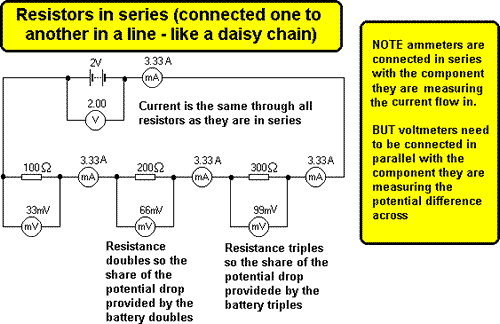
If you examine the formula that we use to calculate the equivalent resistance of a parallel network, you will find that adding any amount of parallel resistance will always result in a lower equivalent resistance. Thus, we can calculate the three branch currents by inserting the resistance value for each branch. Thus, once we know the voltage across a parallel network, we can calculate the current flowing in each branch by dividing the voltage by the branch resistance.īecause this circuit does not contain any components that separate the parallel network from the voltage source, we know that the voltage across the network is 5 V. If we rearrange this equation so that it solves for current, we have The current flowing through parallel resistors is governed by Ohm’s law, which states that voltage (V) is equal to current (I) multiplied by resistance (R). In the following diagram, I 1 and I 2 are branch currents.įor more information on parallel resistance, please read the first article in this series. In the following diagram, one resistor is in parallel with resistance consisting of two resistors.Įach current pathway leading from one node to another is called a branch. Individual resistors can be in parallel, but in a more general sense, one source of resistance can be in parallel with another source of resistance. The following diagrams are examples of parallel resistive networks. Resistors connected in parallel have the same voltage drop, but the currents flowing through these resistors are not necessarily the same.Įlectrically parallel resistors don’t always look like two parallel lines. When two resistors are connected between the same two nodes, they are in parallel. In this article, we'll introduce concepts that will help you with circuit analysis where you may not know the voltage across a parallel resistive network. The various resistances suppose R 1, R 2, R 3 are connected in parallel with each other as shown in the circuit below is known as Parallel Resistance Circuit.How do you analyze a circuit of resistors in parallel? How do you calculate branch current without Ohm's law? The equivalent or total resistance is given by the equation

#Parallel resistance series#
If the various resistances suppose R 1, R 2, R 3 connected together in series as shown in the figure below is termed as a series resistance circuit Series and Parallel Resistance in the circuit

Differential resistance is given by the formula shown below It is the derivative of the ratio of voltage to the current.

It is also known as the incremental or dynamic resistance of the circuit. It is also defined as the slope of the line from the origin through various points on the curve. It determines the power dissipation in an electric circuit. It is similar to the normal resistance of the circuit given as R=V/I. The above equation (6) shows the equation for energy loss in the form of heat. Putting the value of P from the equation (3) in equation (4) we will getĪs we know I = V/R, hence putting the value of I in equation (5) we will get The energy lost in the resistance in the form of heat and is derived as If a current of I ampere is passing through the conductor and the potential difference is V volts across the conductor, then the power absorbed by the resistor is given by the equation (3) shown below
#Parallel resistance free#
The collision of atoms with the free electrons causes the heat to develop when an electric current flows through any conductor or material. The resistance of any conductor is measured by the instrument known as Ohmmeter. Resistivity ( ρ) is defined as the ability of the conductor or the material to oppose the electric current. The resistance of any conducting material is directly proportional to the length of the conductor and inversely proportional to the conductor’s cross-sectional area.



 0 kommentar(er)
0 kommentar(er)
